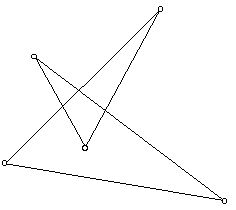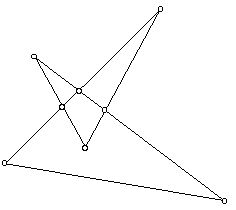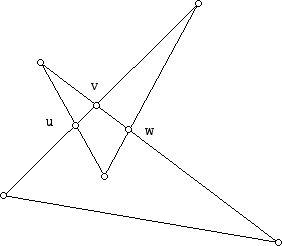
"Knot" Example
Prepared by:
Joseph Malkevitch
Department of Mathematics
York College (CUNY)
Jamaica, New York 11451
email:
malkevitch@york.cuny.edu
web page:
http://york.cuny.edu/~malk
In some notes about Knot Theory, mathematician Louis Kauffman, who specializes in Knot Theory, asks for a proof that "any “knot” made with
5 straight sticks is necessarily unknotted" and asks as well for an explanation for what is "wrong" with the picture below:

The drawing in Figure 1 is in Kauffman's terms to be interpreted literally as a drawing in the plane of straight line segment sticks in 3-dimensional space that form a "knot." However, one might also interpret this diagram, as will be done below, in other ways.
To answer Professor Kauffman's question requires that one know what a knot is and what it means for "something" - like the diagram above - to be unknotted or represent a knot.
First of all, being a knot is a concept which belongs to the geometry of 3-dimensional space. Being knotted is not a property of a self-intersecting curve in the plane. If one draws the diagram above without the "special information" implied by the line segments which are suggested to go above or under others, one would have the graph shown below:

Second, for those familiar with some graph theory, the graph in Figure 2 is not isomorphic (does not have the same structure) as the graph shown in Figure 3.

As a graph, Figure 2 is a cycle of length 5 shown in a drawing which has accidental crossings. The graph has 5 vertices and 5 edges as well as three additional points where edges cross but which are not vertices. By comparison the graph in Figure 3 has 8 vertices. Five of these vertices are 2-valent and 3 of these vertices are 4-valent. At each of the 4-valent vertices one could make a choice, in the sprit of what is required to go from Figure 3 to Figure 2, of whether the two crossing threads one sees at a particular 4-valent vertex goes over or under the other thread at that vertex. To clarify the issue, look at Figure 4. Without any explicit advance knowledge, we can not be sure if what happens at a vertex such as u if we have one single piece of yarn which forms an Eulerian circuit or three pieces of yarn (two of which form "triangles" and the third a non-convex pentagon) and which "kiss" rather than cross at the vertices designated u, v. and w.

If we are following an Eulerian circuit, at u there are two choices for which strand (two segments that meet at u) goes over which; there are also two choices at v, and two choices at w. Thus, there might be as many as eight different "knots" which might be represented by this diagram. However, some of these eight "knots" might be the "unknot," a simple closed curve in three space that is not knotted. Some of these knots that "look different" might actually be isomorphic, so we need some way of determining when two knots are "equivalent" or isomorphic.
Is the problem with Figure 1 that it does not "code" information using its under and over implications so that what is there is truly a knot or is the problem with the diagram that it implies that what is there is a knot but the knot cannot be made with straight line sticks?
From the point of view of teachers and students of mathematics what is involved in the discussions below are a variety of issues of thinking of diagrams from different points of view. Thus, we can view Figure 1 as a knot, as a graph, as a polygon, or as a symbolic picture where straight lines have been shown but where one might also think of all these lines "symbolically" as "curves" instead, rather than as line segments.
Reference:
Kauffman, L., Notes for a course on knot theory:
http://www.math.uic.edu/~kauffman/KFI.pdf